Pamukkale, A Marvel of Nature
Pamukkale appears in almost every list of best historical places (and natural) to be seen before you die and visited by almost two million tourists each year. Pamukkale is a place where nature assumed the role of artist and created such majestic beauty. The white travertine cascades resembling frozen waterfalls and terraces of shallow pools were created by the waters of thermal springs reacting with the air. Its allure first noticed by the Romans. The magnificent Hierapolis ancient city was established near the travertine by the Romans. Those unique travertine and the ancient ruins were inscribed in the UNESCO World Heritage List.
2.000 Year Old Centre of Beauty and Health
Pamukkale would enchant visitors at the first sight. Under the spell of travertine Pergamon Kingdom established the Hierapolis city nearby 2.000 years ago. At that era Hierapolis served as a thermal health center and visitors from various parts of Anatolia flocked to the city to receive a balneal treatment in search of health or beauty. In our age, those who seek beauty or health still dip in the thermal pools. You may also enjoy swimming the timeless pools as your ancestors did, and enjoy the majestic sight of the travertine. However, the natural beauty created over thousands of years is so fragile. Therefore only certain areas are open to paddling or dipping. Those who seek a cure should arrange a longer stay at Pamukkale to enjoy balneal treatment, mud baths, and massages in thermal spa resorts around the city of antiquity and travertine city.
Pamukkale Package Tours
See tour packages from Istanbul that include Pamukkale with at least 1 overnight ;
- Asia Minor Western Promises | 7 Days
- Turkey Western Tour | 8 Days
- Turkey Highlights Tour | 8 Days
- Turkey Western Tour | 10 Days
See our combined packages Turkey and Greece packages from Istanbul that include Pamukkale with at least 1 overnight;
- Turkey and Greece Tour -II-
- Turkey and Greece Tour -III-
- Best of Turkey and Greece with 2 days cruise
- Best of Turkey and Greece with 6-day Island Hopping
- Best of Turkey and Greece with 2 days cruise
Hot Springs
In this area, there are 17 hot water springs in which the temperature ranges from 35 °C (95 °F) to 100 °C (212 °F). The water that emerges from the spring is transported 320 metres (1,050 ft) to the head of the travertine terraces and deposits calcium carbonate on a section 60 to 70 metres (200 to 230 ft) long covering an expanse of 24 metres (79 ft) to 30 metres (98 ft).
When the water, supersaturated with calcium carbonate, reaches the surface, carbon dioxide de-gasses from it, and calcium carbonate is deposited. The depositing continues until the carbon dioxide in the water balances the carbon dioxide in the air. Calcium carbonate is deposited by the water as a soft jelly, but this eventually hardens into travertine.
This reaction is affected by the weather conditions, ambient temperature, and the flow duration. Precipitation continues until the carbon dioxide in the thermal water reaches equilibrium with the carbon dioxide in the atmosphere. Measurements made at the source of the springs find atmospheric levels of 725 mg/l carbon dioxide, by the time this water flows across the travertines, this figure falls to 145 mg/l. Likewise calcium carbonate falls from 1200 mg/l to 400 mg/l and calcium 576.8 mg/l to 376.6 mg/l. From these results it is calculated that 499.9 mg of CaCO3 is deposited on the travertine for every liter of water.
This means that for a flow rate of 1 ı/s of water 43191 grams are deposited daily. The average density of a travertine is 1.48 g/cm3 implying a deposit of 29.2 dm3. Given that the average flow of the water is 465.2 l/s this implies that it can whiten 13,584 square metres (146,220 sq ft) a day, but in practice this area coverage is difficult to attain. These theoretical calculations indicate that up to 4.9 square kilometres (1.9 sq mi) it can be covered with a white deposit of 1 millimetre (0.039 in) thickness.
Hierapolis – Pamukkale
Brief History
Hierapolis’ remains testify to its richness in Roman times. The city was most likely founded by one of Alexander the Great’s successors, and later, in 188 BC, passed into the hands of the Kings of Pergamon. But evidence suggests that this place was occupied long before that – in prehistoric times – probably as a place of worship around the cave of Plutonium. The area around the cave is currently not accessible, along with the Sanctuary of Apollo, and the Temple Nymphaeum.
Hierapolis means ‘holy city’ or ‘sacred city’, and the consensus is that the name probably originates from the religious traditions that arose around this cave. Fast forward to the 1st century AD when Hierapolis became involved in industrial activities such as wool production and fabric dyeing. Strabo mentioned that the hot thermal water was used to fixate the color of the wool.
In the Christian Era, Hierapolis transforms quickly and matures – much like nearby Laodicea – to an influential city with large communities of Christians and Jews. It later becomes a Bishopric, and gained enormous prestige with its tomb of the Apostle Philip.
After 616, it was struck by a violent earthquake from which it never fully recovered. The city became more ruralized in the centuries to follow, only to be conquered by the Seljuks somewhere in the first part of the 13th century. By the 15th century, the city was left abandoned until it was rediscovered by western travelers, such as Raymond Chandler, in 1765.
Virtual Tour of Hierapolis
As the travel plans of so many of us collapsed with the spread of the coronavirus pandemic, the only possible way to visit the archaeological sites and museums is to go online and check which collections have already been digitized. In the case of Turkey, the Ministry of Culture and Tourism established Sanal Muze website that offers a 3D experience of some of the best-known state-run archaeological and ethnographic museums. The downside of this project is the fact that even though the museums offer descriptions of the exhibits, they are only available in Turkish at the moment.
Travertines
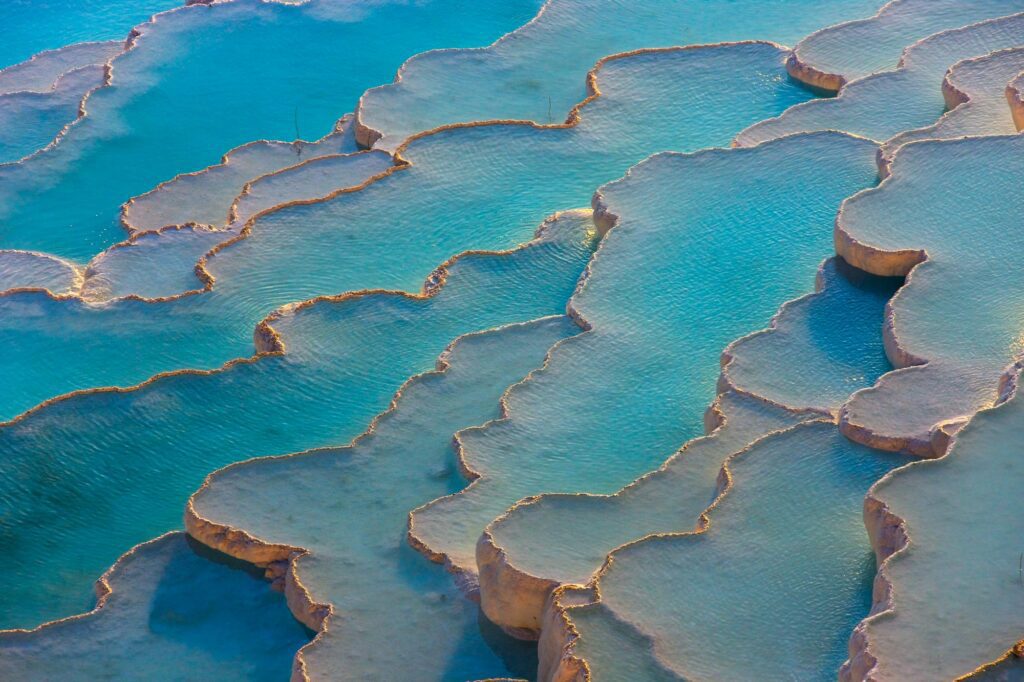
The dazzling white calcite cliff of Pamukkale was created by calcium deposits from the area’s hot springs. In the same way that stalactites form within limestone caves, the deposits grow on the steep slopes, gradually fanning out to form natural terraces. Pamukkale means “cotton castle,” and the blinding white color of these travertines do look like a bizarre natural fortress of sorts. The best way to do your sightseeing here is to walk (barefoot only) from the base of the calcite mountain up the entire cliff ridge. The terraces at the upper levels hold pools of water, which you can sit in.
Legendary Temples
The Hierapolis city of antiquity has reached our times in a quite well preserved state. The most frequented structure of the antiquity should have been the Roman Baht House, and at present the same building is used as the archeological museum. Many artifacts were unearthed during the excavations carried out in Hierapolis and other nearby sites of antiquity, and some of the statues and other items are on display in the museum. The ancient theater, temples, monumental fountains, necropolis, agora, and gymnasium are quite well preserved to make you feel travelling 2.000 years back in time. You would find the story of Pluto’s Gate (Plutonium) which was believed to be the Gate of Hell during the Roman Era, very fascinating.
St. Philip Martyrium and Gravesite
In Christianity Hierapolis, Pamukkale is a holy settlement. The holiness is attributed to the fact that St. Philip, one of the Twelve Apostles of Jesus Christ, was martyred in the city. The Martyrium was built by the palace architects in 5th century, and it is a holy pilgrimage site for Christians. The ruins of Cathedral dating back to 6th century contain the baptistery as well as metropolitan bishop’s chapel. The 7th century church is renowned as the Church of Columns (Direkli Kilise) is the other important structure from Christian era. There are several other chapels scattered around the town. Those structures prove that Hieropolis was an important religious centre during the Eastern Roman Empire era. That is the reason why the archaeologists named it as the holy city.
The Incredible Theater of Hierapolis
The Theatre at Hierapolis offers stunning views and is still in use nowadays, at least by the odd tourist performing an out-of-the-blue serenade during your visit. We’re confident that attending a classical concert at this venue would no doubt be a real feast for your senses. This is the most visited structure in Hierapolis.
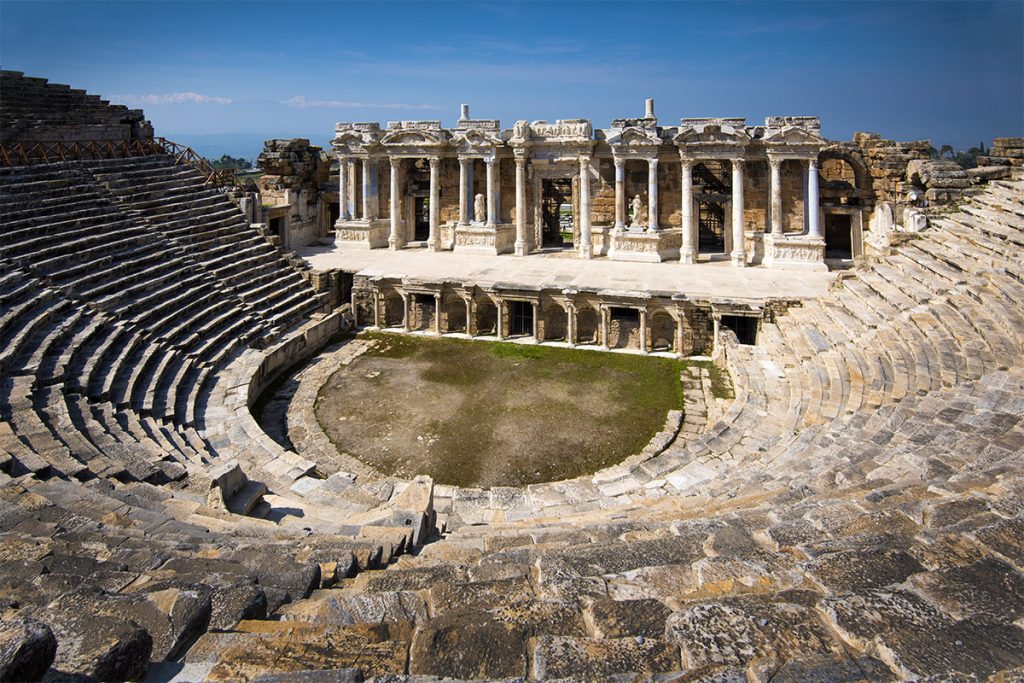
The Theatre was built in three different phases, the first phase being from the end of the 1st century BC till the beginning of the 1st century AD. By the end of this first phase, the Theatre had a smaller stage with a Doric façade and a Skene on two levels.
The third phase – in the 4th century AD – makes room for something different when the Theatre is restored, and the orchestra makes room for a large pool for aquatic spectacles. The pool was lined with a waterproof mortar, and a had a piping-system in place to fill or empty it. Research and restoration work on the Theatre is ongoing and started in the summer of 1957 by the Italian Archaeological Mission of Hierapolis in Phrygia. Their focus lies on preservation and restoration, and in recent years, both the stage and the Skene have been reconstructed and restored, allowing the visitors to gain a unique insight in the Baroque architecture of Asia Minor. Future ideas include the introduction of different itineraries in and around the Theatre to enhance the building and its context. The inner itinerary will follow the ancient passages for the public, once they have been restored.
Frontinus Street
Frontinus Street is Hierapolis’ main street. It connects the Central Hamam area to the Necropolis and the North Gate. The street was made in the 1st century AD, together with the gate with the same name. It is 14 meters wide and has a covered main drain in the center. The street was sided by numerous buildings such as shops, houses, warehouses, a fountain building, and latrines, all unified by a 170-meter long travertine façade.
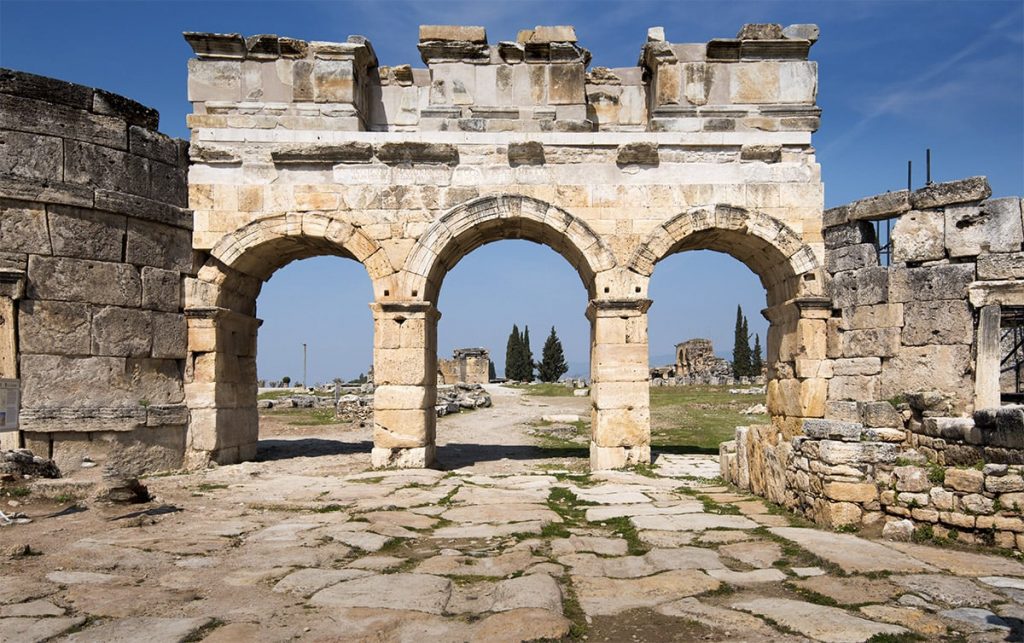
Frontinus Street could only be brought to light after pneumatic compressors broke through the 2-meter thick layer of calcareous deposit that covered it.
The Latrines
The Latrine right next to the Frontinus Gate was built at the end of the 1st century AD. While it had collapsed entirely after an earthquake, its elements were preserved, allowing an almost complete reconstruction. A row of columns separates the room into two corridors. Each had their row of seats and drains.
Necropolis
Pamukkale, Hierapolis is home to the most important and monumental Necropolis in the whole of Asia Minor. Located in the north part of the city, it extends for nearly two kilometers, featuring impressive funeral buildings belonging to different periods.
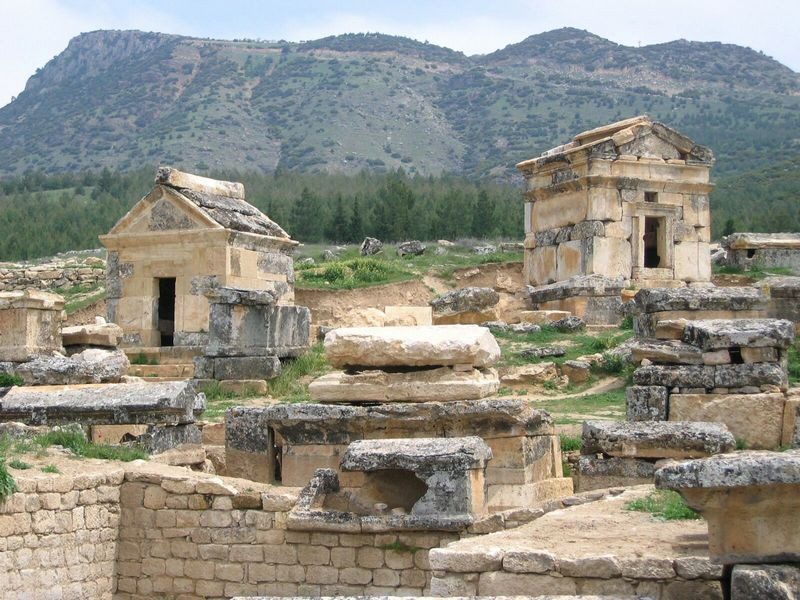
Hierapolis Museum

This small but excellent museum dedicated to Hierapolis is inside the ancient city’s former Roman bath house. A visit here will help bring the city to life. The exhibits showcase some of the beautiful artistry and cultural heritage of this once important city, displaying a variety of finds from the site, including gorgeous and intricate stone reliefs, sarcophagi, and statuary. The museum also has a decent collection of statuary from the nearby archaeological site of Aphrodisias
Other Sites Near Pamukkale
Laodikeia

Lovely Laodikeia, about 12 kilometers south of Pamukkale, was once home to Cicero. This Roman commercial center was a bustling city of industry, medicine, and trade. As Christianity began to take over from the earlier pagan religions, a large population of Christians and Jews lived here. The ruins, though sparse, are highly photogenic, and there’s an interesting mix of remnants from the temples and theaters of early Roman settlement to the later Christian early-Byzantine era. It’s a bit off the normal Pamukkale area itinerary (which usually just visits the terraces and Hierapolis), so if you have this on your things to do list, you’re likely to get the entire site to yourself.
Aphrodisias
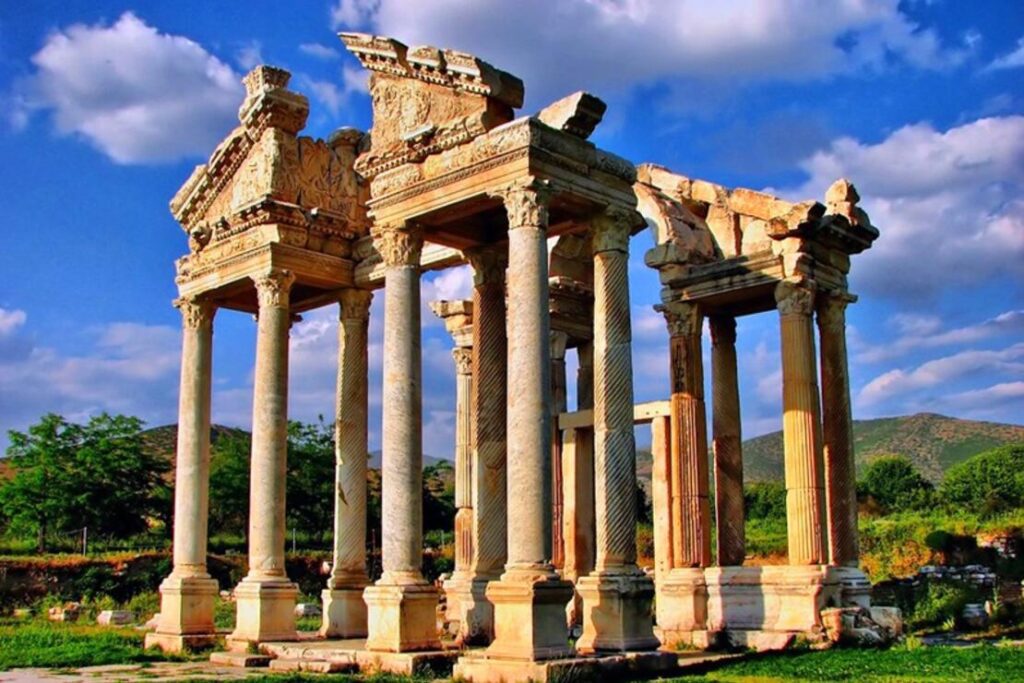
Modern research has transformed Aphrodisias from a place few visited into one of the most important historic sites in Turkey. About 97 kilometers southwest of Pamukkale, the site produced Chalcolithic finds, which show the area was settled in the 4th millennium BC, and early Bronze Age pottery finds also suggest there was an Assyrian trading colony here during the Hittite period. The settlement’s golden age though was in the Hellenistic and Roman eras, when its sanctuary became the center of the wide-spread Aphrodite cult, and the city also became famous for its schools of sculpture, medicine, and philosophy. The Temple of Aphrodite was built in approximately 100 BC and still has 14 standing columns (two with architraves in place). In the 5th century, the Byzantines converted this pagan temple into a three-aisled basilica. To the north is the mammoth and well-preserved Stadium, which could hold 30,000 spectators. To the south of the temple is the bouleuterion, decorated with reliefs and statues, the best preserved monument in the site.










